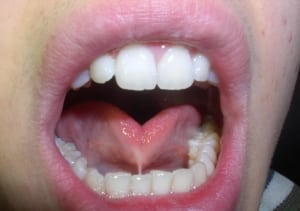Babies with tongue and lip ties have difficulty because their lips or tongue are held too tight to their jaws and gums by tissue, making moving the mouth challenging and resulting in breastfeeding issues.
Frenulums
Frenulums in the mouth are pieces of tissue that attach the tongue to the lower jaw and upper and lower lips to the gums. Most of us have frenulums that we can feel with our tongues. If you push your tongue between your upper lip and upper gums or between your lower lip and lower gums, it feels as if there’s a small string connecting them. Having some of this tissue is perfectly normal, but some people are born with more tissue than they need.
Tongue and Lip Ties
Infants with a tongue tie have a frenulum that is too short, connecting towards the tip of the tongue. They occur in 1-10% of infants and are more common among children who are born male. Tongue ties happen more frequently in breastfed infants and certain environmental or genetic factors. If a tongue tie goes untreated, the baby may have issues breastfeeding, taking bottles, or gaining weight.
Lip ties occur with a short frenulum between the gums and lips. They are normal and usually do not coordinate with breastfeeding issues.
Clinical Features of Tongue Ties
- Short frenulum
- Unable to lift the tongue
- Unable to protrude the tongue
- Impaired side to side movement
- Unable to insert a finger under the tongue, between the tongue and lower mandible
Mothers may notice that their baby’s latch is off just by feel. In this case, it’s always better to check with a lactation consultant to attain the deepest latch possible.
How to Release Tongue and Lip Ties
A frenotomy (clipping of the frenulum) is used to correct the issue if there is excessive pain during breastfeeding and your infant fails to thrive. This repair will seal quickly with minor bleeding and a low risk of infection. After the procedure, your baby may have a sore mouth, and you may need to help stretch the tissue with your fingers. In most cases, the baby is ready to breastfeed immediately, and you will begin to feel the difference.
Diagnosing and treating tongue and lip ties are essential. If they go untreated, the baby will continue to have issues breastfeeding and taking bottles. In addition, tongue and lip ties can affect speech later on and cause tooth decay due to food being pushed into the pockets on either side of the tie. Also, it will save you the headache of sleepless nights and an unhappy baby!
For questions or comments, please respond to this blog post or contact us.









